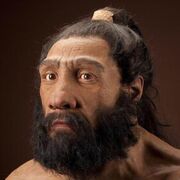No edit summary |
(Adding categories) |
||
| Line 37: | Line 37: | ||
Wall, J.D., Yang, M.A., Jay, G., Kim, S.K., Durand, E.Y., Stevison, L.S., & ...Slatkin, M. (2013). Higher levels of Neanderthal ancestry in East Asians than in Europeans. ''Genetics'', 194(1), 199-21SI. <span style="color:rgb(73,72,72);font-family:ff-dagny-web-pro,'HelveticaNeue',Arial,sans-serif;font-size:12px;line-height:18px;">Baillie, C.P.T. (2013). Neandertals: Unique from Humans, or Uniquely Human? Krober Anthropological Society Journal, 103, 93-107.</span> <span style="color:rgb(73,72,72);font-family:ff-dagny-web-pro,'HelveticaNeue',Arial,sans-serif;font-size:12px;line-height:18px;">Baillie, C.P.T. (2013). Neandertals: Unique from Humans, or Uniquely Human? Krober Anthropological Society Journal, 103, 93-107.</span> |
Wall, J.D., Yang, M.A., Jay, G., Kim, S.K., Durand, E.Y., Stevison, L.S., & ...Slatkin, M. (2013). Higher levels of Neanderthal ancestry in East Asians than in Europeans. ''Genetics'', 194(1), 199-21SI. <span style="color:rgb(73,72,72);font-family:ff-dagny-web-pro,'HelveticaNeue',Arial,sans-serif;font-size:12px;line-height:18px;">Baillie, C.P.T. (2013). Neandertals: Unique from Humans, or Uniquely Human? Krober Anthropological Society Journal, 103, 93-107.</span> <span style="color:rgb(73,72,72);font-family:ff-dagny-web-pro,'HelveticaNeue',Arial,sans-serif;font-size:12px;line-height:18px;">Baillie, C.P.T. (2013). Neandertals: Unique from Humans, or Uniquely Human? Krober Anthropological Society Journal, 103, 93-107.</span> |
||
[[Category:Human evolution]] |
[[Category:Human evolution]] |
||
| + | [[Category:Neanderthals]] |
||
Latest revision as of 16:17, 2 December 2013
The ancient hominids known as Neanderthals existed across most of Asia and Europe between 30,000 and 300,000 years ago (Wall et al., 2013). Their ancestry has been hotly debated, but they are likely a subspecies of the genus Homo, sharing some characteristics with anatomically modern humans (Baillie, 2013). Questions arise as to whether Neanderthals interbred with Homo sapiens, as fossil records are unclear, however some DNA evidence suggests that they may have contributed to the modern gene pool (Wall et al., 2013).
Brief History
Neanderthals were first discovered in 1856, and were named after the locale where they were found: the Neander Valley in Germany (Baillie, 2013; "Neanderthal", 2013). Fossil specimens of all ages have been collected, allowing for a fairly accurate picture of the species at all stages of life (Baillie, 2013). Over 400 fossil specimens of Neanderthal individuals have been found from all across Europe, and some of Western Asia ("Neanderthal", 2013). The climate at the time of the Neanderthals was fiorefront in defining their facial features such as wide nasal cavities (Baillie, 2013). Additionally, the overall anatomy of Neanderthals is believed to be a response to keeping them warm, specifically with regards to leg length (which were shorter than humans) (Etting, 2008).
As with humans, Neanderthals are believed to have built and used tools such as spears, ornaments, blades, and other objects (Baillie, 2013).
Recent evidence from mitochondrial DNA shows a divergence of modern humans with Neanderthals around 466,000 years ago (Brown, 2010).
Ancient DNA
Sequencing DNA from two ancient Neanderthal specimens, scientists have been able to show different traits of Neanderthal appearance. It is believed that Neanderthals probably had pale skin and red hair, similar to modern day humans. This assumption is based on the mutated receptor gene, melanocortin 1 receptor (MCR1), which is not found in modern humans (or rarely). This gene mutation changes an amino acid, and similar mutations found in modern human genes result in red hair and pale skin (Smithsonian National Museum of Natural History, 2013).
Since the MCR1 gene is not found in humans, scientists have concluded that the evolution of red hair and pale skin happened independently; therefore it does not support the idea of gene flow between humans and Neanderthals (Smithsonian National Museum of Natural History, 2013).

Reconstruction of a Neanderthal (without red hair). http://humanorigins.si.edu/evidence/genetics/ancient-dna-and-neanderthals/neanderthal-genes-red-hair-and-more
References
Baillie, C.P.T. (2013). Neanderthals: Unique from Humans, or Uniquely Human? Kroeber Anthropological Society Journal, 103, 93-107.
Brown, T. (2010). Human Evolution: Stranger from Siberia. Nature, 464, 838-839.
Etting, S.S., (2008). Assessing the adaptive significane of Neanderthal morphology. Current Anthropology, 49(3), 359-360.
Neanderthal. (n.d.). Retrieved from http://en.wikipedia.org/wiki/Neanderthal
Smithsonian National Museum of Natural History. (2013, November 11). Ancient dna and neanderthals. Retrieved from http://humanorigins.si.edu/evidence/genetics/ancient-dna-and-neanderthals/neanderthal-genes-red-hair-and-more
Wall, J.D., Yang, M.A., Jay, G., Kim, S.K., Durand, E.Y., Stevison, L.S., & ...Slatkin, M. (2013). Higher levels of Neanderthal ancestry in East Asians than in Europeans. Genetics, 194(1), 199-21SI. Baillie, C.P.T. (2013). Neandertals: Unique from Humans, or Uniquely Human? Krober Anthropological Society Journal, 103, 93-107. Baillie, C.P.T. (2013). Neandertals: Unique from Humans, or Uniquely Human? Krober Anthropological Society Journal, 103, 93-107.